Analyzing Z370 for Intel's 8th Generation Coffee Lake: A Quick Look at 50+ Motherboards
by Ian Cutress, Anton Shilov, Joe Shields & Gavin Bonshor on October 20, 2017 2:00 PM ESTASRock Z370M-ITX/ac and Z370 Gaming-ITX/ac
The last two ASRock boards left in their current Z370 lineup are the Z370M-ITX/ac and the Z370 Gaming-ITX/ac. While their pedigree is a bit different, with the latter coming from the Gaming line, they are both mini-ITX sized boards intended to fit in small form factor cases. Due to the size, neither SLI nor Crossfire support is possible due to only one PCIe slot in place, but the idea for this size is to have a small powerhouse. The Gaming-ITX/ac will have more or higher-end features and will come in at a higher price point out of the two, because it also has an onboard Thunderbolt 3 chip.
The Gaming-ITX board, as all mITX sized boards seem to, look pretty cramped as there is very little free space on the board. This board uses a heatpipe to connect the power delivery heatsink to the chipset heatsink, with the Thunderbolt controller also taking advantage. Only the Gaming-ITX has a reinforced PCIe slot at the bottom of the board, which is rated to PCIe 3.0 x16 from the processor. As far as overall looks, there isn’t really a theme so much as it is a black PCB with a lot going on in a small space. The board does have red LEDs on the bottom by the PCIe slot and does and an RGB header for adding additional flare.
The Z370M-ITX also doesn’t have much in the way of beautification going either. On this board all six of its power delivery phases have a heatsink, but it is noticeably smaller than the one in the Gaming-ITX and is not connected via a heatpipe to the chipset heatsink (which is also slimmed down). Due to the smaller chipset heatsink, the M.2 slot on the Z370M-ITX is located on the front of the board, just above the non-reinforced PCIe slot, rather on the rear.
Memory capacity is limited to one module per channel, due to having two slots instead of four because of the size. Similar to the other ASRock boards, the quoted speeds for these two boards are higher than the other vendors, with the Gaming version supporting DDR4-4333 and the standard Z370M-ITX going for DDR4-4000. Interestingly for the PCIe slot, the Gaming-ITX/ac specifications does mention support for PCIe riser cards to extend one x16 slot to two x8 slots, should users have access to an appropriate riser card. That being said, the system does not ship with SLI certification, and thus support may be limited to Crossfire in this scenario.
Both boards have a single PCIe 3.0 x4 based M.2 slot, with the Z370M-ITX having it on the front and the Z370 Gaming-ITX on the rear. Despite some of the larger boards from other vendors having only four SATA ports, ASRock goes for all six on both of the mini-ITX boards, and placed such that interlocking cables should not interfere with each other if drives need to be removed.
For fan headers, they each have three, with ASRock's 'CPU Optional/Water Pump' fan header able to output 1.5A/18W. Both of them also have Wi-Fi modules, although the one in the Gaming uses the Intel AC8265 while the Z370M-ITX uses the AC3165. The boards differ in audio, with Gaming-ITX/ac using the Realtek ALC1220 and adding all the bells and whistles from the Gaming line (Nichicon Gold Series audio caps, T.I NE5532 headset amplifier), compared to the Z370M-ITX which uses a Realtek ALC892. The boards also differ on networking in favor of the Z370M-ITX which has dual Intel (I219-V, I211-AT) whereas the Gaming-ITX only has one (I219-V).
The key difference in the support between the two boards is going to be the Thunderbolt 3 port on the Gaming-ITX. This port supports video outputs and USB 3.1. Other USB support on the back panel of the Gaming-ITX/ac is provided by the six USB 3.1 (5 Gbps) ports. Elsewhere on the panel is a combination PS/2 port, a clear CMOS button, the antenna connectors, HDMI video output, DisplayPort video output, the ethernet connection, the audio jacks, and SPDIF.
For the Z370M-ITX/ac, there is no Thunderbolt port, but in its place are two HDMI ports. This comes with the DisplayPort to round out the video outputs. USB connectivity comes from two USB 2.0 ports and six USB 3.1 (5 Gbps) ports. The two network ports look fairly ominous, but are paired with the Wi-Fi module just next door. The audio supplies three jacks, with no SPDIF here.
| ASRock Z370 Gaming-ITX/ac and Z370M-ITX/ac | ||
| Z370 Gaming ITX/ac | Z370M-ITX/ac | |
| Warranty Period | 3 Years | |
| Product Page | Link | Link |
| Price | Amazon US | Amazon US |
| Size | ATX | |
| CPU Interface | LGA1151 | |
| Chipset | Intel Z370 Express | |
| Memory Slots (DDR4) | Two DDR4 Supporting 32GB Dual Channel |
|
| Support DDR4-4333 | Support DDR4-4000 | |
| Network Connectivity | 1 x Intel I219-V Intel AC8265 Wi-Fi |
1 x Intel I219-V 1 x Intel I211-AT Intel AC3165 Wi-Fi |
| Onboard Audio | Realtek ALC1220 | Realtek ALC892 |
| PCIe from CPU | 1 x PCIe 3.0 x16 slot | |
| PCIe from Chipset | None | |
| Onboard SATA | 6 x Supporting RAID 0/1/5/10 | |
| Onboard SATA Express | None | |
| Onboard M.2 | 1 x PCIe 3.0 x4 | 1 x PCIe 3.0 x4 |
| Onboard U.2 | None | |
| USB 3.1 (10 Gbps) | 1 x Type-C (via Thunderbolt) | None |
| USB 3.1 (5 Gbps) | 6 x Back Panel 1 x Header |
|
| USB 2.0 | 1 x Header | |
| Power Connectors | 1 x 24-pin EATX 1 x 8-pin ATX 12V |
|
| Fan Headers | 1 x 4-pin CPU (1A/12W) 1 x 4-pin CPU Opt (1.5A/18W) 1 x 4-pin Chassis Fan |
|
| IO Panel | 2 x Antenna ports 1 x Combo PS/2 1 x HDMI port 1 x DisplayPort 1.2 1 x Intel TB3 (Type-C) 1 x Optical SPDIF out 6 x USB 3.1 (5 Gbps) 1 x RJ-45 LAN port 1 x Clear CMOS button 6 x Audio Jacks |
2 x Antenna ports 1 x Combo PS/2 2 x HDMI ports 1 x DisplayPort 1.2 2 x USB 2.0 ports 6 x USB 3.1 (5 Gbps) ports 2 x RJ-45 LAN ports 3 x Audio Jacks |


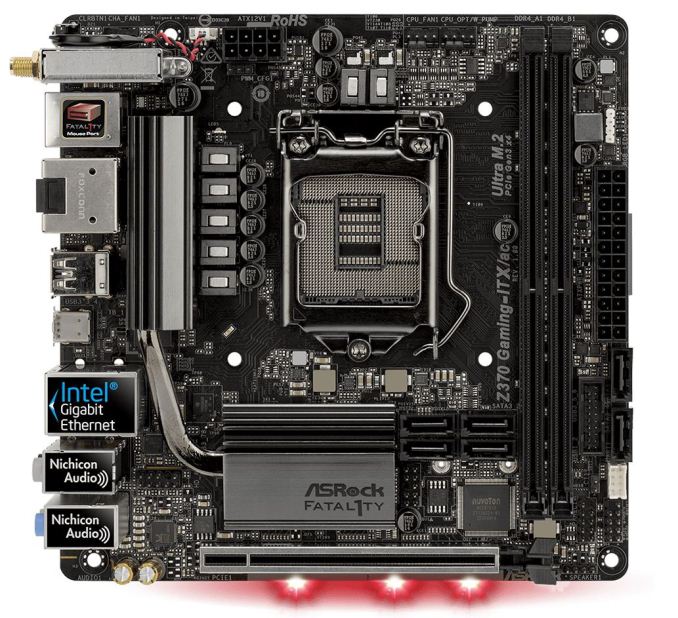
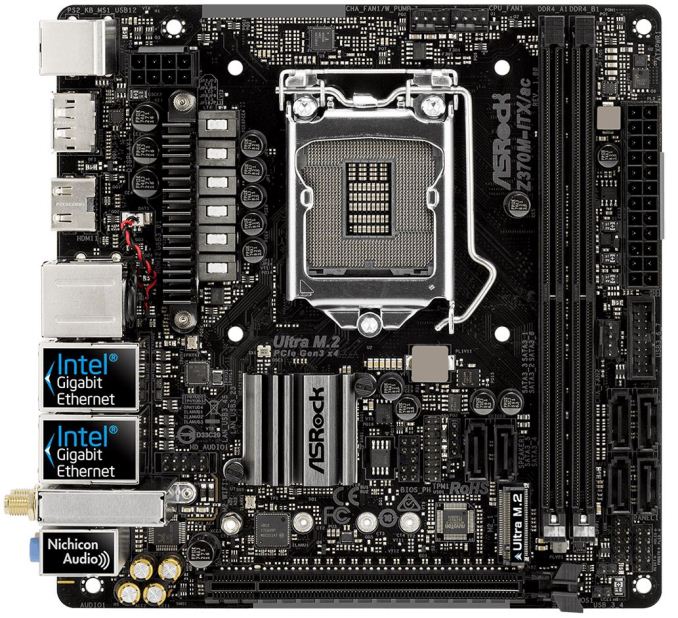
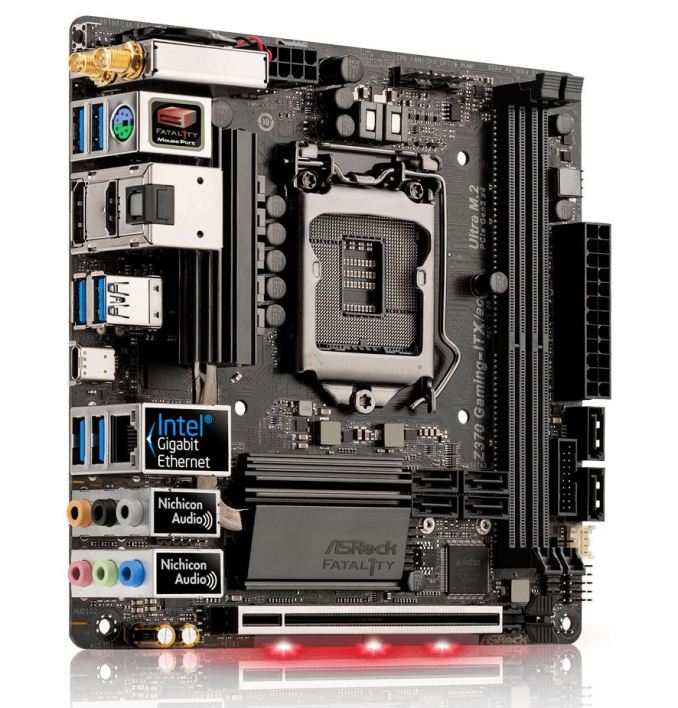
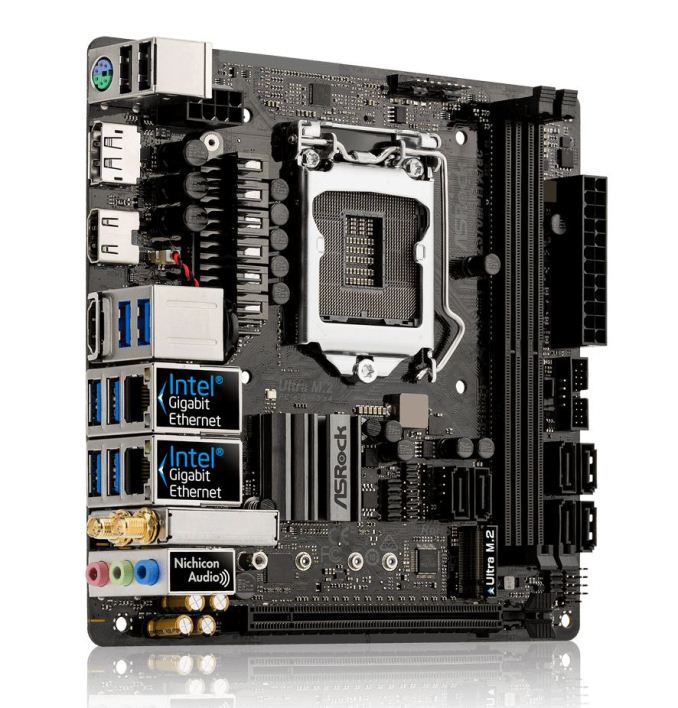
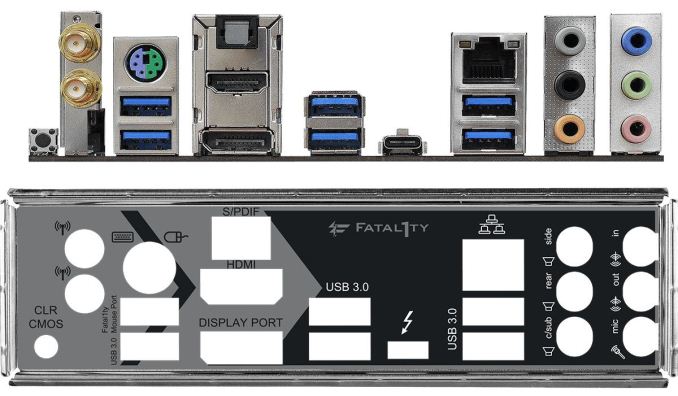









83 Comments
View All Comments
risa2000 - Saturday, October 21, 2017 - link
It seems that the PCB which holds the silicon has changed between the 7th and the 8th gen. So they most likely needed to validate the CPU. The fact that they did not move the notch means they just did not want to (could not) introduce a new socket. Either because there were so many of the old ones, or there was no time, or they did not want to push the cost to MB manufacturers to revalidate the new sockets.shabby - Friday, October 20, 2017 - link
For a split second i thought finally some x370 goodness... but no.Shame, shame, shame!
tamalero - Saturday, October 21, 2017 - link
I'm waiting for actual non clown disco BS Threadripper motherboards :(ikjadoon - Friday, October 20, 2017 - link
Amazingly well done. Excellent write-up.AbRASiON - Friday, October 20, 2017 - link
Stupid question, I got the AsRock simple ITX board and it won't turbo my CPU at all (8400) like no turbo PERIOD. It never ever goes over 2763mhz?Anyone got any ideas on this? Am I just stupid and this is normal behaviour or what?
https://forums.anandtech.com/threads/am-i-doing-so...
bernstein - Friday, October 20, 2017 - link
FYI: GIGABYTE Z370N-WiFi is also HDMI 2.0 capableByte - Friday, October 20, 2017 - link
If nothing else, Asus makes some damn good looking boards.docbones - Friday, October 20, 2017 - link
My big question still on the z370 is whats the 390 going to bring? Will the 370 not support a octocore chip?shabby - Friday, October 20, 2017 - link
This is intel we're talking aboot, new chip = new mobo period.Ro_Ja - Saturday, October 21, 2017 - link
Once Kaby Lake E is released, that's a new mobo again.